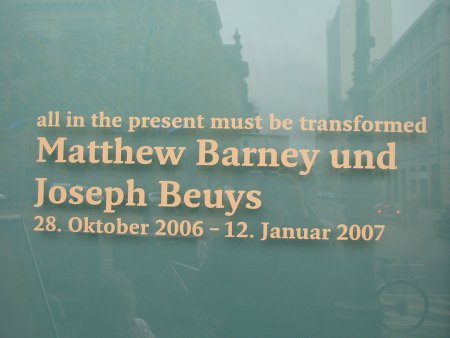All in the Present Must Be Transformed

Yesterday the exhibition “All in the Present Must Be Transformed” featuring the artists Matthew Barney and Joseph Beuys opened with an interview with Matthew Barney at the Deutsche Guggenheim in Berlin.
The exhibition was curated by curator Nancy Spector who did also the interview with Matthew Barney. As she describes on the Guggenheim page
It’s a very sensitive and risky thing to do, you know, juxtaposing two artists’ work, when only one of them can speak to the situation. This project is about shared concerns and similar sensibilities, but it also reveals essential and meaningful differences. By reading Barney and Beuys together, one can, I hope, learn something new about both artists.
To my opinion this worked very well. I had seen both artists seperately and on other occasions, however the juxtaposition of both of them in this exhibition with its particular choice of works gave me a new look on their respective oeuvre.
It was also the first time that I saw so much fragile figurative works of Beuys. In the exhibitions I have seen before (including solo exhibitions) much more value was set on his performative works and symbolism. – I liked that almost tender Beuys better. And it was also Matthew Barney’s works which appeared in a very different light than the one, one gets by watching his striking cremaster cycle only.
Both artists are very different, but it is right the difference got highlighted by the comparison. Conspicuous to me was that Matthew Barney draws a lot of attention to frames. There are beautiful frames in sometimes coloured elastomere, plastic display cabinets, where the cabinet itself played an equal important role as the objects inside. Due to the strong appearance of the frame the images and objects inside assumed – together with the frame – a graphical component. Almost like as if they were an illustration. Unfortunately I cant show you images, which could explain what I mean, as it was strictly forbidden to take pictures, even without a flash and without a tripod.
I dont know what the reason for this forbiddance was – may be they wanted to promote their beautiful but expensive catalog (see below) or they were fearing odd fotographic reproductions. However you can find some images on the exhibitions homepage on the arts curriculum page and especially under the link to drawing restraint 9.
The interview was quite interesting. In the interview Barney explained that “parts of Cremaster failed in overcoming their own condition” and that a careful choice of environment became important to him. He mentioned the example of a TV set in a room, which draws all attention onto itself. And that it became important for him to create a “nonhierachical situation in a room”, which could function as an “animated space”. In particular he noted (a little later on) that “when sculpture becomes an image it looses its presence”. It was also important to him to do his videos without an immediate audience, which would have meant a distraction. So the “landscape condition could overcome the emotional space”. But on the other hand Matthew Barney didnt want exclude the possibility of having an immediate audience in general.
There were many other issues under discussion, for me however the above point of sculpture/image/space and presence was the most interesting. As a consequence it was interesting for me to know how Matthew Barney would relate to virtual space and in particular to lets say 3D sculpture in virtual space…:). And even more specific I wanted to know wether he thinks that a sculpture would loose its presence in virtual space.
Hesitatingly he answered that he thinks that a virtual sculpture could function as a sculpture.
(words in quotation marks from my notes – without guaranty)